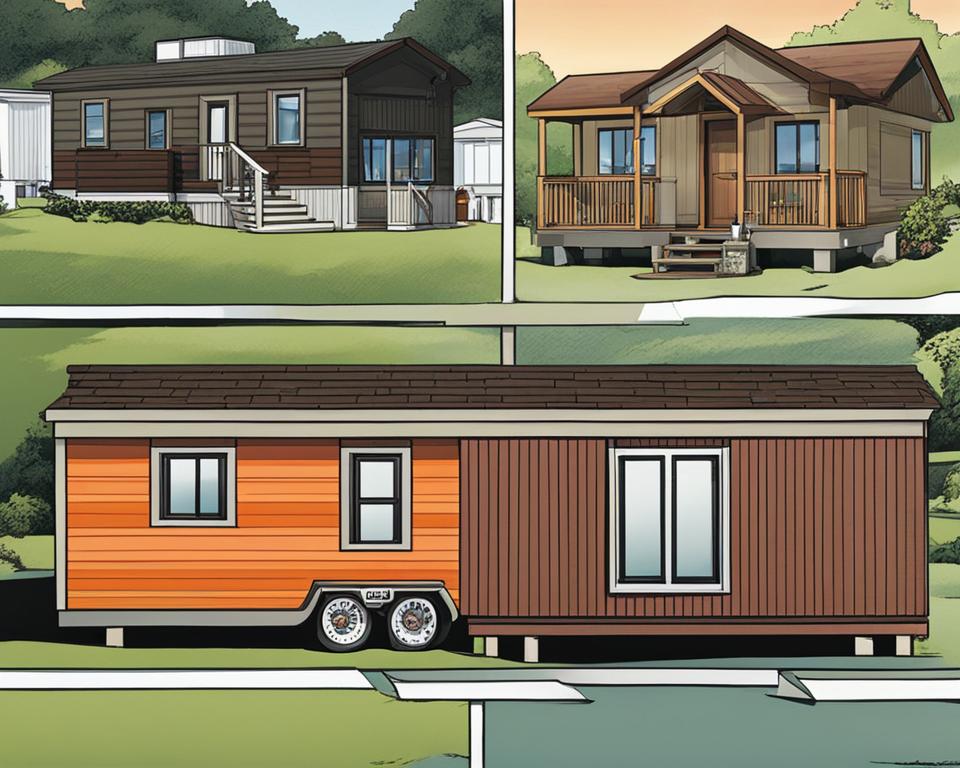Mobile homes and manufactured homes may often be used interchangeably in everyday conversation, but there are important distinctions between the two. Understanding these differences is crucial, especially when it comes to classification, insurance, design, and foundation considerations.

Key Takeaways:
- Mobile homes were built before June 15, 1976, while manufactured homes were built after that date following the HUD code.
- Both mobile homes and manufactured homes are regulated by the Department of Housing and Urban Development (HUD).
- Mobile homes often have pier and beam foundations, while manufactured homes can be placed on various types of foundations.
- Insurance coverage for mobile homes and manufactured homes differs, with specific policies required for each.
- Modular homes, another type of factory-built home, must adhere to local building codes.
Classification and Insurance Considerations
When it comes to mobile homes and manufactured homes, understanding their similarities and differences is essential for classification and insurance purposes. While these terms are often used interchangeably, there are key distinctions that must be considered.
Mobile homes, which can also be referred to as manufactured homes, require specific insurance coverage. It is crucial to correctly classify the type of home you have before obtaining an insurance quote. On the other hand, modular homes typically require a standard homeowners policy.
To summarize:
- Mobile homes and manufactured homes may use the same term, but they require different insurance coverage.
- Modular homes generally fall under standard homeowners insurance policies.
Understanding these classification and insurance considerations will ensure that your home is properly protected.
Design and Construction Differences
When it comes to design and construction, mobile homes and manufactured homes share many similarities. Both types of homes are built in factories and then transported to the property where they will be set up. This prefabrication process allows for efficient and controlled construction, resulting in shorter build times and cost savings.
However, there are some notable distinctions. Modular homes, for instance, must adhere to local building codes. This ensures that they meet specific construction standards and regulations, similar to site-built homes. Additionally, modular homes are often delivered in multiple pieces and assembled on-site. This method allows for greater flexibility in design and customization, as well as easier transportation to remote locations.
In terms of appearance, modular homes closely resemble traditional “stick-built” homes. They can be built on crawlspaces or basements, providing a more permanent foundation. This allows for a seamless integration with the surrounding neighborhood and a higher level of customization. From the outside, it is often difficult to distinguish a modular home from a site-built home. Inside, modular homes offer the same level of comfort and functional layout as traditional homes.
| Design and Construction Differences | Mobile Homes | Manufactured Homes | Modular Homes |
|---|---|---|---|
| Construction Location | Factory-built | Factory-built | Factory-built |
| Transportation | Moved in one piece | Moved in one piece | Delivered in multiple pieces |
| Foundation | Pier and beam | Pier and beam or permanent foundation | Crawlspace or basement |
| Appearance | May resemble traditional homes or have a more mobile appearance | May resemble traditional homes | Resembles traditional stick-built homes |
| Customization | Limited | Limited | High level of customization |
Foundation and Relocation Considerations
When it comes to mobile homes and manufactured homes, one of the key differences lies in their foundation and the ability to relocate them. Mobile homes often have pier and beam foundations, which allow for potential relocation by a specialized contractor. This means that if you own a mobile home, you have the option to move it to a different location if needed. On the other hand, manufactured homes can also be placed on permanent foundations, crawl spaces, or basements, making them more suitable for long-term or permanent placement.
Another way to differentiate between mobile homes and manufactured homes is by the presence of a tag. Mobile and manufactured homes often have a tag, which is a yearly renewal sticker indicating that the home can be moved or relocated. This tag is a requirement for homes that fall under the mobile or manufactured home classification. So, if you see a home with a current tag, it’s a clear indication that it is either a mobile or manufactured home, depending on the construction date.
When considering the foundation and relocation options of mobile homes and manufactured homes, it’s important to assess your specific needs and plans for the future. If you anticipate the possibility of moving your home to a different location, a mobile home with a pier and beam foundation may be the better choice. If, however, you prefer a more permanent placement, a manufactured home on a permanent foundation or other suitable options would be more suitable.
Table: Foundation and Relocation Differences
| Features | Mobile Homes | Manufactured Homes |
|---|---|---|
| Type of Foundation | Pier and beam | Permanent foundations, crawl spaces, basements |
| Potential Relocation | Can be moved by specialized contractors | More suitable for long-term or permanent placement |
| Presence of Tag | Required for homes that can be moved or relocated | N/A |
In summary, the foundation and relocation considerations are defining factors that set mobile homes apart from manufactured homes. While mobile homes can be relocated due to their pier and beam foundation and presence of a tag, manufactured homes are typically placed on permanent foundations or other suitable options. Understanding these distinctions is essential when making decisions about home placement and potential future moves.
History and Regulation
The terms “mobile home” and “manufactured home” have evolved over time. Originally referred to as trailers, mobile homes became more common in the 1930s and 1940s when manufacturers started mass-producing them. In the 1950s, mobile homes transitioned to permanent residences but developed a poor reputation. To combat this perception, the industry introduced stricter standards and changed the name to “manufactured homes” in 1976. The HUD code was established to regulate the construction and quality of manufactured homes, ensuring they met specific design, durability, and safety standards.
Today, manufactured homes are built to meet rigorous standards enforced by HUD. These standards cover various aspects of construction, including the electrical systems, plumbing, heating, and ventilation. The HUD code also sets forth requirements for the structural integrity of the home, ensuring it can withstand transportation and installation.
“The introduction of the HUD code revolutionized the manufactured home industry by improving quality and safety standards. This has led to the production of beautiful, well-built homes that offer an affordable housing option for many individuals and families.”
Manufactured homes are subject to periodic inspections during the construction process to verify compliance with the HUD code. Once the home is completed, it receives a label certifying its compliance. This label, commonly known as the HUD tag, is affixed to the exterior of the home and serves as proof that the home meets the approved standards. The presence of the HUD tag is essential for financing, insurance, and resale purposes.
Comparison Between Mobile Homes and Manufactured Homes
| Mobile Homes | Manufactured Homes | |
|---|---|---|
| Year Built | Before June 15, 1976 | After June 15, 1976 |
| Regulation | Minimal standards, less regulated | HUD code compliance |
| Transportability | Potentially movable | Permanent installation |
| Pier and Beam Foundation | Common | Depends on location |
| HVAC System | Window units or separate systems | Central heating and cooling |
While both mobile homes and manufactured homes have played significant roles in meeting the housing needs of individuals and families, the shift from mobile homes to manufactured homes brought about important regulatory changes. These changes have raised the quality and safety standards for manufactured homes, ensuring they are built to withstand transportation, installation, and long-term occupancy. Understanding the history and regulation behind these housing types can help individuals make informed decisions when considering a mobile home or manufactured home as their residence.
Conclusion
In conclusion, while there are similarities between mobile homes and manufactured homes, it is crucial to understand their differences. The key distinction lies in the classification and date of construction. Mobile homes were built before July 15, 1976, while manufactured homes adhere to the HUD code and were built after that date.
Additionally, the perception of mobile homes has evolved over time. Once considered to be of lower quality, manufactured homes now meet strict standards and offer beautiful and functional living spaces that are comparable to site-built homes.
Understanding these similarities and contrasts is essential for accurate classification and insurance coverage. By correctly classifying your home and obtaining the appropriate insurance, you can ensure that your investment is protected. Whether you own a mobile home or a manufactured home, both offer comfortable and affordable housing options.
FAQ
What is the difference between mobile homes and manufactured homes?
Mobile homes were built before June 15, 1976, while manufactured homes are those built after that date. Both types are regulated by the Department of Housing and Urban Development (HUD) and share common traits, such as being built in a factory. However, modular homes must adhere to local building codes.
What insurance coverage is needed for mobile homes and manufactured homes?
Mobile homes, which can also be called manufactured homes, require specific insurance coverage. Prior to obtaining insurance, it is crucial to correctly classify the type of home you have. For modular homes, a standard homeowners policy is typically required.
How are mobile homes, manufactured homes, and modular homes constructed?
Mobile homes and manufactured homes are both built in factories and then transported to the property where they will be set up. Modular homes also follow a similar process but they must adhere to local building codes and are often delivered in multiple pieces.
What types of foundations do mobile homes and manufactured homes have?
Mobile homes often have pier and beam foundations, allowing for potential relocation by a specialized contractor. Manufactured homes can also be placed on permanent foundations, crawl spaces, or basements.
How have mobile homes and manufactured homes evolved over time?
Originally referred to as trailers, mobile homes transitioned to permanent residences in the 1950s. To combat negative perceptions, the industry introduced stricter standards and changed the name to “manufactured homes” in 1976. The HUD code was established to regulate their construction, design, durability, and safety.
What are the key distinctions between mobile homes and manufactured homes?
The main distinction lies in the date they were built. Mobile homes refer to homes built before June 15, 1976, while manufactured homes are those built after that date following the HUD code. Additionally, modular homes must adhere to local building codes.

![Ray Dalio Quotes [Principles, Life, Investment]](https://tagvault.org/wp-content/uploads/2023/04/Screen-Shot-2023-04-19-at-7.57.49-PM.png)